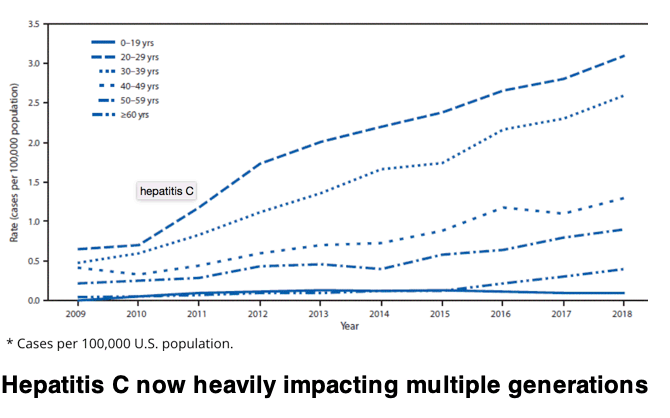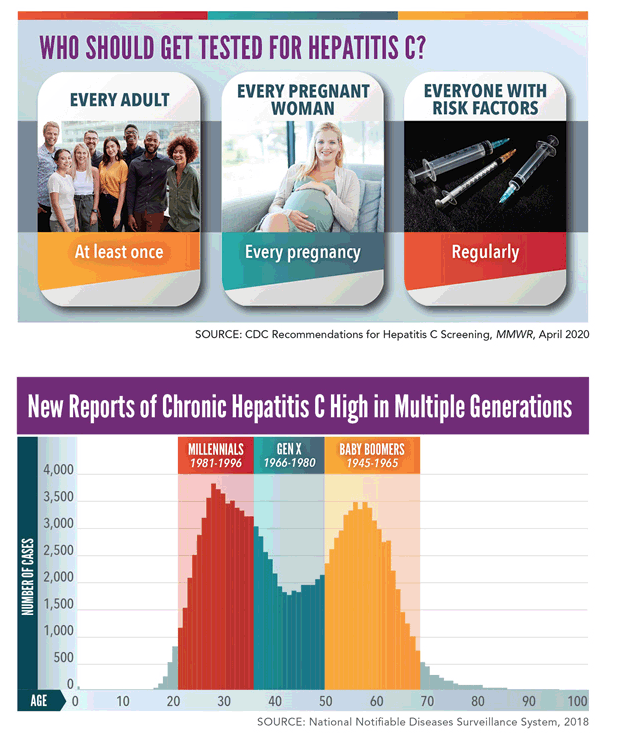| |
|
New HCV Cases Tripled / 1 Million Unaware they have HCV / Get Tested - Get Cured
|
| |
| |
• acute hepatitis C tripled from 2009 to 2018.
• Get tested. Get cured. essentially 95%++ cure rates now with short term treatment
• nearly 1 million Americans with hepatitis C who don't know they have it.
• This is a curable disease
New Reports of Chronic Hepatitis C High in Multiple Generations. In 2018:
• Millennials (most adults in their 20s and 30s) made up 36.5% of newly reported chronic hepatitis C infections.
• Baby boomers (most adults in their mid-50s to early 70s) made up 36.3% of newly reported chronic hepatitis C infections.
• Generation X (adults in their late 30s to early 50s) made up 23.1% of newly reported chronic hepatitis C infections.
CDC's new hepatitis C screening recommendations call for:
• One-time screening for all adults 18 years and older
• Screening of all pregnant women during every pregnancy
• Testing for all persons with risk factors, with testing continued for those with ongoing risk.
The annual rate of reported acute hepatitis C tripled from 2009 to 2018 and was highest among persons aged 20-39 years. In 2018, the largest proportion of chronic hepatitis C cases occurred among persons aged 20-39 years and 50-69 years. Only 61% of adults with hepatitis C knew that they were infected.....CDC estimates there were about 50,300 new hepatitis C infections in 2018. 2018 marked a decade of increases in new hepatitis C infections among people in their 20s and 30s, with injection drug use as the primary route of transmission. "The opioid crisis shifted the course of the hepatitis C epidemic in less than a decade," said Dr. Mermin. "There are nearly 1 million Americans with hepatitis C who don't know they have it. This is a curable disease-no one should have to look back knowing something as simple as a blood test could have changed their life or the life of their loved one."
Treatment for hepatitis C can cure the disease, eliminating a serious and potentially deadly health threat to those with the infection, and preventing transmission to others. That's why increased testing, prevention services and treatment are so vital to the health of both those living with hepatitis C and those at risk for the infection. These services can be provided in a range of settings, including:
• Comprehensive syringe services programs
• Substance use disorder programs such as medication-assisted treatment programs
• Other healthcare settings such as primary care clinics and emergency departments
"Every case of liver failure and each death from this disease is a preventable tragedy," said Carolyn Wester, MD, MPH, director of CDC's Division of Viral Hepatitis. "Our hope is that universal screening and increased access to treatment will significantly improve the health of millions of Americans who already have hepatitis C and also help to stop the epidemic of hepatitis C infections among all generations."......https://www.cdc.gov/mmwr/volumes/69/wr/mm6914a2.htm?s_cid=mm6914a2_w

April 9, 2020 - Data emphasize importance of new CDC hepatitis C screening recommendations for all adults
New data show chronic hepatitis C infection affects every generation-underscoring new CDC recommendations that every adult should be tested at least once in their lifetime for this curable infection.
https://www.cdc.gov/nchhstp/newsroom/2020/hepatitis-c-impacting-multiple-generations.html
New Reports of Chronic Hepatitis C High in Multiple Generations. In 2018:
• Millennials (most adults in their 20s and 30s) made up 36.5% of newly reported chronic hepatitis C infections.
• Baby boomers (most adults in their mid-50s to early 70s) made up 36.3% of newly reported chronic hepatitis C infections.
• Generation X (adults in their late 30s to early 50s) made up 23.1% of newly reported chronic hepatitis C infections.
CDC's new hepatitis C screening recommendations call for:
• One-time screening for all adults 18 years and older
• Screening of all pregnant women during every pregnancy
• Testing for all persons with risk factors, with testing continued for those with ongoing risk.

| |
| |
| |
|
|
|